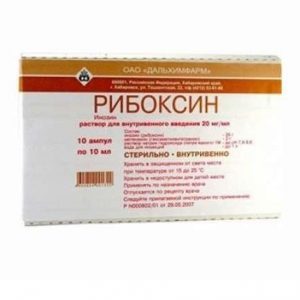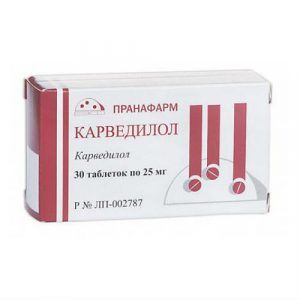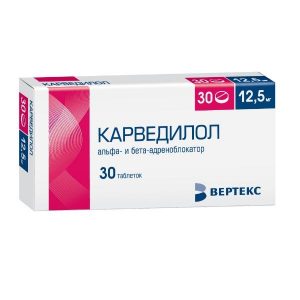Description
Latin name
Kordaflex RD
Release form
Coated controlled-release tablets.
packaging 30 pcs
Indications
– arterial hypertension of various genesis, including hypertensive crises (for 10 mg tablets)
– IHD: for the prevention of seizures in various forms of angina pectoris, including angiospastic (Prinzmetal angina)
– Raynaud’s syndrome (for prolonged-release tablets).
Contraindications
– acute stage of myocardial infarction
– cardiogenic shock
– severe arterial hypotension (systolic blood pressure below 90 mmHg)
– severe aortic or mitral stenosis, idiopathic hypertrophic hypertension pregnancy
– lactation (breastfeeding)
– children and adolescents under 18 years old
– hypersensitivity to nifedipine and other components of the drug.
With caution, Cordaflex ® should be used in case of chronic heart failure, hypertrophic obstructive cardiomyopathy, severe cerebrovascular accident, cardiovascular system, severe tachycardia, and severe liver and / or kidney dysfunction, malignant arterial hypertension, in patients undergoing hemodialysis (due to the risk of severe arterial hypotension due to peripheral vasodilation), with lactose intolerance, as well as elderly patients.
Pregnancy and lactation
Cordaflex ® is contraindicated for use in the first trimester of pregnancy.
The use of Cordaflex in pregnant women is indicated only in cases where normalization of blood pressure is not possible when using other antihypertensive drugs.
Because nifedipine is excreted in breast milk, avoid the use of Cordaflex during lactation or stop breastfeeding during treatment with the drug.
Composition
Nifedipine
Excipients: microcrystalline cellulose, lactose monohydrate, croscarmellose sodium, hydroxypropyl cellulose, 30 T polyvinyl butyral, talc, magnesium stearate.
Dosage and administration
The dosage regimen is set individually, depending on the severity of the disease and the patient’s response to the therapy.
Adults Cordaflex ® in the form of coated tablets is prescribed 10 mg (1 tab.) 3 times / day. If necessary, the dose of the drug can be increased to 20 mg (2 tablets) 1-2 times / day. The maximum daily dose is 40 mg. The interval between doses of the drug is at least 2 hours.
To accelerate the effect of the drug at the beginning of the development of an attack of angina pectoris or hypertensive crisis, the tablet should be chewed, held in the mouth for a while, and then swallowed with a small amount of water.
If it is necessary to increase the dose to 80-120 mg / day for the treatment of angina pectoris or arterial hypertension, it is recommended to transfer the patient to take the drug in the form of prolonged-release tablets.
During the course of therapy, it is recommended to use Cordaflex ® in the form of sustained-release tablets. The initial dose is 20 mg (1 tab.) 2 times / day with an interval of 12 hours. If necessary, the dose of the drug is gradually increased until the optimal clinical effect is achieved. For long-term maintenance therapy, as a rule, it is enough to take 20-40 mg (1-2 tablets) 2 times / day. The maximum daily dose is 120 mg.
In elderly patients, the pharmacokinetics of nifedipine changes, and therefore the initial dose of the drug is reduced by 2 times and lower doses may be required to maintain the therapeutic effect.
For moderate hepatic or renal impairment, dosage adjustment is not required. With severe impaired liver function, the maximum daily dose should not exceed 40 mg.
The drug is in the form of tablets containing 10 mg of nifedipine, taken orally before meals, in the form of tablets of prolonged action – regardless of the meal, without chewing, washed down with a little water.
Side effects of the
From the cardiovascular system: at the beginning of treatment – facial skin hyperemia, marked decrease in blood pressure, tachycardia, peripheral edema (ankles, feet, legs) rarely – frequent angina attacks (which is typical for other vasoactive drugs and requires drug withdrawal ), heart failure.
From the side of the central nervous system and peripheral nervous system: headache, dizziness, fatigue, drowsiness with prolonged use in high doses – paresthesia in the limbs, tremor.
From the digestive system: nausea, heartburn, diarrhea or constipation rarely with prolonged use – intrahepatic cholestasis, increased activity of hepatic transaminases (pass after drug withdrawal) in some cases – gingival hyperplasia.
From the hemopoietic system: rarely – thrombocytopenia, thrombocytopenic purpura, leukopenia in some cases – anemia.
From the urinary system: increased daily diuresis rarely – impaired renal function in patients with chronic renal failure.
From the musculoskeletal system: myalgia is very rare – arthritis, arthralgia.
Allergic reactions: rarely – urticaria, exanthema, skin itching very rarely – photodermatitis.
Other: in some cases – visual impairment, gynecomastia, hyperglycemia (completely disappear after drug discontinuation), change in body weight, galactorrhea.
In the vast majority of cases, the drug Cordaflex ® RD is well tolerated by patients.
Drug Interaction
The combination of Kordaflex with beta-blockers, diuretics, ACE inhibitors, and nitrates is rational in terms of enhancing antihypertensive and anti-anginal action. All of the above combinations are safe and effective in most clinical situations because they result in summation or potentiation of effects, but in some cases there is a risk of marked decrease in blood pressure and an increase in symptoms of heart failure.
The combination of Kordaflex with clonidine, methyldopa, octadine, prazosin according to indications is possible, but can cause severe orthostatic hypotension.
An increase in the antihypertensive effect is also seen with combination therapy with cimetidine, ranitidine and tricyclic antidepressants.
Nifedipine increases the concentration of digoxin and theophylline in blood plasma, therefore, the clinical effect and / or the content of digoxin and theophylline in blood plasma should be monitored.
Procaine, quinidine and other drugs that cause QT prolongation increase the negative inotropic effect and increase the risk of QT prolongation. Under the influence of nifedipine, the concentration of quinidine in the serum is significantly reduced, which appears to be due to a decrease in its bioavailability, as well as the induction of quinidine inactivating enzymes. Upon withdrawal of nifedipine, there is a transient increase in quinidine concentration (approximately 2-fold), which reaches a maximum level by 3-4 days. Caution should be exercised when using such combinations, especially in patients with impaired left ventricular function.
Nifedipine may displace drugs with a high degree of binding (including indirect anticoagulants – coumarin and indandione derivatives, NSAIDs), which may result in increased plasma concentrations.
When administered with rifampicin, phenytoin and calcium, nifedipine is impaired.
Nifedipine inhibits the excretion of vincristine from the body and may cause an increase in the adverse effects of vincristine, if necessary reducing the dose of vincristine.
Diltiazem suppresses the metabolism of nifedipine in the body, reducing the dose of nifedipine if necessary.
Grapefruit juice, erythromycin and antifungal drugs of the azole group (fluconazole, intraconazole, ketoconazole) can suppress the metabolism of nifedipine and therefore enhance its effects.
Similarly, co-administration of Cordaflex and cimetidine increases the plasma nifedipine concentration, enhances its effects, but concomitant administration with ranitidine does not significantly increase the plasma nifedipine concentration.
Because nifedipine is metabolized by the CYP3A4 isoenzyme, any inhibitor or inducer of this enzyme may affect the metabolism of nifedipine. Cyclosporine is also a substrate for the CYP3A4 isoenzyme, so when combined with cyclosporine and nifedipine, each may increase the duration of the other.
Overdose
Symptoms: headache, arterial hypotension, and (as well as under the influence of other vasodilators) myocardial energy supply disorder (angina pectoris).
Treatment: Immediately after the overdose as a first aid, you can wash your stomach and give activated charcoal. If necessary, you can do the washing of the small intestine, which is especially advisable in the case of overdose of controlled release drugs.
Because nifedipine is highly bound to plasma proteins, dialysis is not effective, and plasmapheresis may be effective.
Symptoms of cardiac arrhythmias with bradycardia can be eliminated by administration of beta sympathomimetics. For life-threatening bradycardia, an artificial rhythm driver should be used.
Norepinephrine (norepinephrine) infusion at standard doses is indicated for severe arterial hypotension. In the development of symptoms of heart failure, it is recommended to / in the introduction of fast-acting glycosides of digitalis.
Symptomatic therapy has been shown in the absence of a specific antidote. Dopamine, isoprenaline and 10% calcium gluconate (10-20 ml I / O) can be used as antidotes.
Storage conditions
At a temperature of 15 ° to 25 ° C.
Expiration
4 years.
Deystvuyuschee substances
nifedipine
Conditions of supply of
Pharmacy Prescription
dosage form
dosage form
tablets




